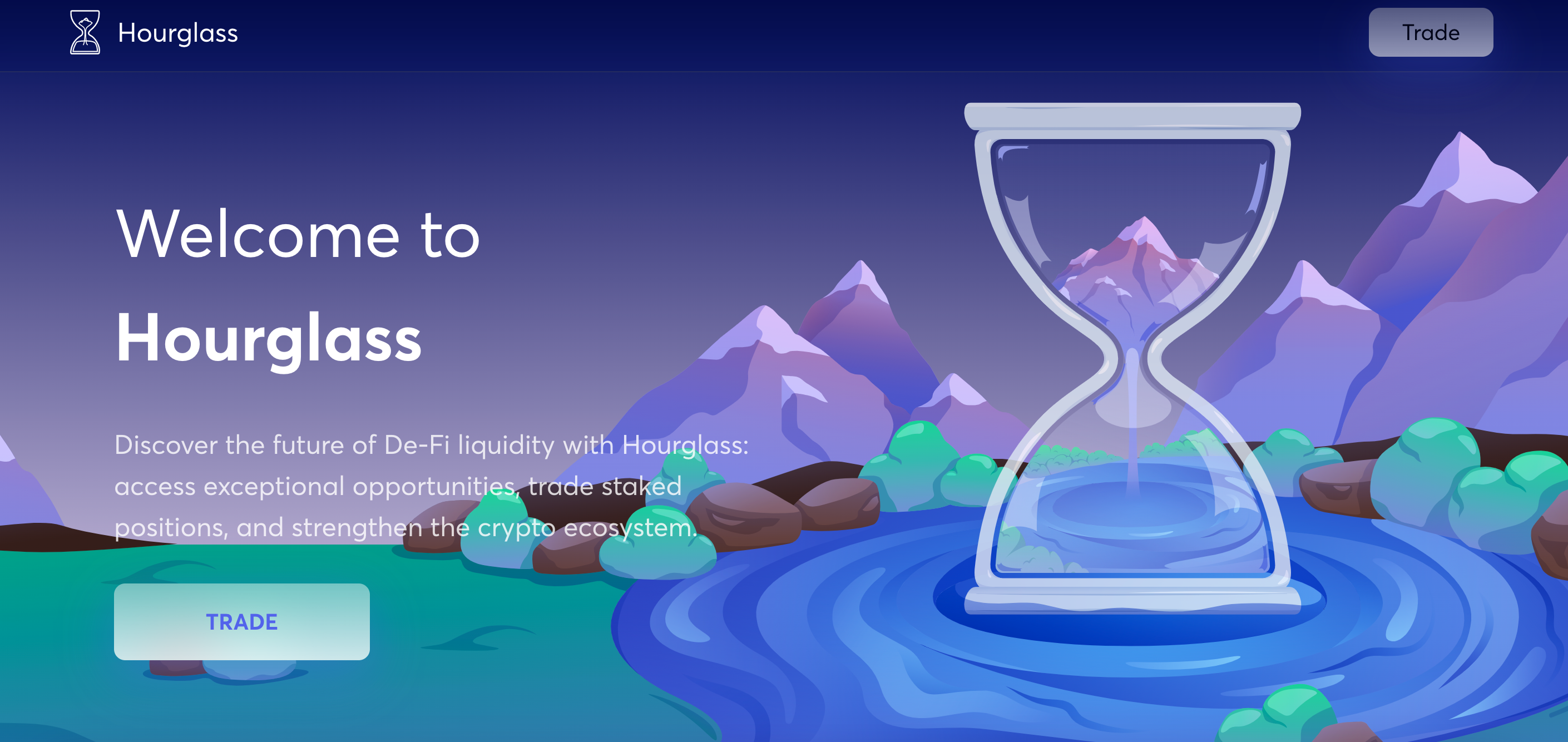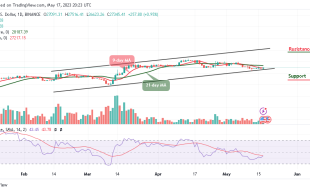Join Our Telegram channel to stay up to date on breaking news coverage
In a groundbreaking move, crypto startup Hourglass has unveiled a revolutionary marketplace designed specifically for trading Time-Bound Tokens (TBTs).
Hourglass Unveils Innovative Marketplace for Time-Bound Tokens in DeFi
The concept aims to tokenize a user’s locked assets within a decentralized finance (DeFi) protocol based on the duration of their lock-up period.
The primary objective of the marketplace is to enable users to exchange their position in the queue for their locked assets, essentially transferring ownership of assets that have been locked within a protocol to another interested buyer.
Charlie Pyle, the founder of Hourglass, explained the simplicity of the process, stating, “You can essentially acquire a time-bound token and easily transfer ownership of it.”
Hourglass has chosen an opportune moment to launch its marketplace, coinciding with the rollout of Lido’s Version 2 deployment this week. The startup’s innovative approach involves tokenizing the withdrawal queue of Lido, a prominent player in the liquid staking domain.
Time is money.
Today, we’re launching the first-ever marketplace where time can be traded, alongside our $4.2M seed round led by @ElectricCapital.
Mint, buy, and sell our novel DeFi primitive — time-bound tokens (TBTs) — at https://t.co/Hsa7kSBEXc today.
1/8 pic.twitter.com/oTLOF0XSfG
— Hourglass ⏳ (@hourglasshq) May 16, 2023
By doing so, Hourglass aims to address the potential issue of a congested withdrawal path that could potentially impede users’ access to their staked ether for extended periods, lasting weeks or even months. Users will have the opportunity to trade their position in the queue, granting them temporary liquidity while awaiting their withdrawal.
Notably, Lido stands as the leading liquid staking platform within the DeFi landscape, boasting an impressive total value locked (TVL) exceeding $12 billion across the Ethereum ecosystem, as reported by DefiLlama.
The integration of Lido’s withdrawal queue into the Hourglass marketplace further solidifies the platform’s position as a frontrunner in the realm of DeFi innovation.
The introduction of Hourglass’s marketplace signifies a significant advancement in the realm of DeFi, providing users with newfound flexibility and liquidity for their locked assets.
As the largest liquid staking platform, Lido’s partnership with Hourglass exemplifies the industry’s commitment to continuously push the boundaries of decentralized finance, propelling the sector into an era of unprecedented accessibility and efficiency.
Here’s How Hourglass’s New Marketplace Will Work
Hourglass’s innovative marketplace provides users with an opportunity to gain liquidity from their locked assets by selling the rights to the duration of their lock-up period on a secondary market.
This marketplace revolves around a growing class of tokens known as Time-Bound Tokens (TBTs), which represent staked assets in decentralized finance (DeFi) protocols that are committed for a specific period of time, as stated in a press release by Hourglass.
As stated by the company, the marketplace is designed to accommodate a wide range of assets, enabling users to trade locked frxETH (Frax ether token) and make early exits from Lido’s withdrawal queue.
To provide an example, let’s consider a scenario where a user decides to stake 10 Frax ether in the Frax protocol for a period of one month. In return, they will be granted 10 TBTs, along with any rewards earned from staking. These TBTs can be freely exchanged on the marketplace, offering users the flexibility to engage in seamless trading activities.
Similar to other secondary markets, the platform will offer discounts on TBTs based on the duration of the locked-up assets.
For instance, a trader could bid for a 3% discount on ether (ETH) with a 10-month lock-up period, and the discount may vary depending on the length of time the asset is locked up, explained Charlie Pyle, the founder of Hourglass.
The issuance of TBTs will be facilitated by “Hourglass custodian smart contracts” and will adhere to the ERC1155 standard, creating semi-fungible tokens. Pyle clarified that even though the smart contracts bear the name “custodian,” it is important to note that the TBTs operate on a non-custodial basis. This means that the founding team does not exercise control or authority over the assets that have been deposited.
Throughout the lock-up period, the locked assets, which TBTs represent ownership of, will be held securely within the custodian smart contracts. At the end of the lock-up period, users will have the option to redeem their matured TBTs for the corresponding assets, providing a seamless and reliable process, added Pyle.
Currently, Hourglass does not impose any fees for trading on its platform, offering users a cost-effective solution to unlock liquidity from their locked assets.
As for the funding, Hourglass has successfully raised $4.2 million in a seed round led by Electric Capital. Notable investors participating in the round include Coinbase Ventures, Circle Ventures, Tribe Capital, hack.vc, and several angel investors, showcasing strong support and confidence in the project’s potential.
Lido Finance Launches V2, Driving Token Surge and Solidifying Ethereum Dominance
Lido Finance recently launched its highly anticipated second version, dubbed “V2.” This upgrade had a significant impact on Lido’s native governance token, LDO, as its value surged by 10%, reaching $2.15 within a 24-hour period.
Following a successful on-chain vote, Lido V2 is officially here.https://t.co/36EmuagToD
— Lido (@LidoFinance) May 15, 2023
With the V2 upgrade, Lido users now have the ability to unstake their stETH (staked Ether) and receive ETH at a 1:1 ratio.
While many users can finalize the process in a single day, it is worth noting that according to Rated, a reputable network explorer, validators might encounter a withdrawal timeframe of up to 5 days and 14 hours when attempting to exit the staking queue.
As part of the unstaking procedure, users are provided with an NFT that symbolizes their request for withdrawal. This NFT acts as an intermediate stage before acquiring ETH rewards. Upon claiming the rewards, the NFT is extinguished.
Despite the possibility of listing the NFT for trading on platforms such as Blur and Opensea, Lido’s marketing lead, Kasper Rasmussen, emphasized that secondary market transactions have no influence on the withdrawal process.
Notably, Lido has established a dominant position in Ethereum’s liquid staking derivatives, capturing an impressive market share of approximately 80%, as reported by Nansen. The platform’s withdrawals of over 278,000 ETH further solidify its position as one of the top entities in terms of ETH withdrawals, ranking fourth behind prominent exchanges like Kraken, Coinbase, and Binance.
Lido placed great emphasis on a thorough auditing process for the V2 upgrade, with nine audits conducted by firms such as Statemind and MixBytes. One audit by Oxorio is expected to conclude by the end of May.
The V2 transition is significant as it aims to reduce risks associated with Lido’s tech stack, enhancing security and reliability. Kydo, Vice President of Stanford Blockchain Club, highlighted the improved ability to enter and exit the staking process, leading to a derisked user experience, as stated by Rasmussen.
Read More:
Best Wallet - Diversify Your Crypto Portfolio
- Easy to Use, Feature-Driven Crypto Wallet
- Get Early Access to Upcoming Token ICOs
- Multi-Chain, Multi-Wallet, Non-Custodial
- Now On App Store, Google Play
- Stake To Earn Native Token $BEST
- 250,000+ Monthly Active Users
Join Our Telegram channel to stay up to date on breaking news coverage



